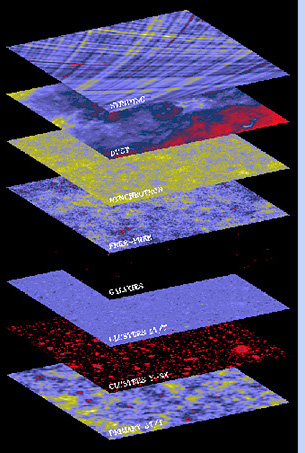 |
||
| Separation of the Foregrounds from the Primordial Fluctuations | ||
|
Figure 1: This figure shows the kind of foregrounds and issues involved in separating out the interesting cosmological signals
The extraction of the cosmological background fluctuations down to a few arc minutes and with sensitivity per pixel of about 10E-6 in T/T requires a good separation of the different components of the background. More specifically, it is necessary to identify:
The anticipated spectrum of these various components and their fluctuations are shown as a function of frequency and distribution on the sky in Figures 2 and 3 below. The strategy for this separation to the accuracy required by these ambitious cosmological objectives is based on two factors: near-total sky coverage, which will allow accurate modeling of these components where they are strongest on the sky; and a broad spectral coverage to allow the measurement of their spatial structure, or the detection of the sources at frequencies where they stand out above the cosmological background fluctuations.
Figure 2: Galactic and extra galactic emission spectra. The different spectral dependence of Galactic foreground components (synchrotron emission, free-free emission, and thermal emission from interstellar dust) have spectral indices of approximately -2.8, -2.1 and 1.5. The width of the bands corresponds to variations in the range of Galactic latitudes between 15 and 70 degrees. The vertical lines show the four frequencies of the LFI measurements. The antenna temperature of the CMB and the amplitude of the CMB dipole and quadrupole are also shown. (See figure 1). _____________________________________________________________________
Figure 3: Estimated fluctuation levels due to Galactic polar emission (dashed lines) and to extra galactic sources (solid lines), from Toffolatti et al. 1993. The final limitations are expected to be due to the residual inaccuracies in the component separation. For spiral and starburst galaxies they are dominated by the fluctuations of the background due to weak sources undetected in the highest frequency channel. For cirrus they will be dominated by the possible presence of cold interstellar dust with a different distribution from that of the dust seen by IRAS. In both cases the highest frequency channel will be used in combination with the IRAS data to study the properties of the long wavelength spectrum of these sources. The choice of the frequency of this channel will depend on a trade-off between the required sensitivity to detect the sources (better at higher frequencies) and the identification of colder components not seen by IRAS.
|
||


